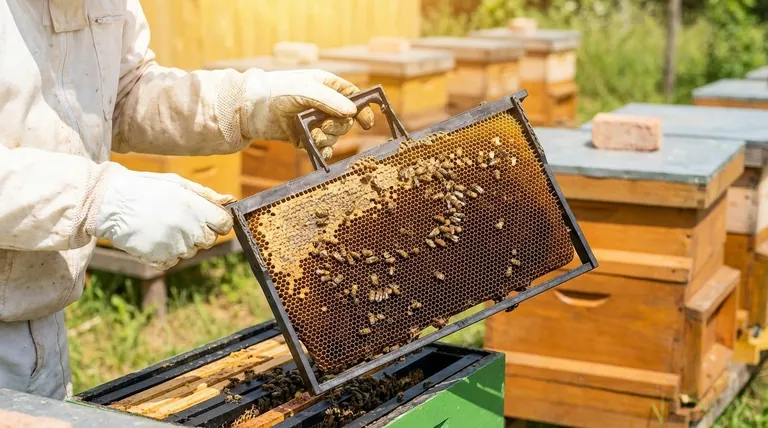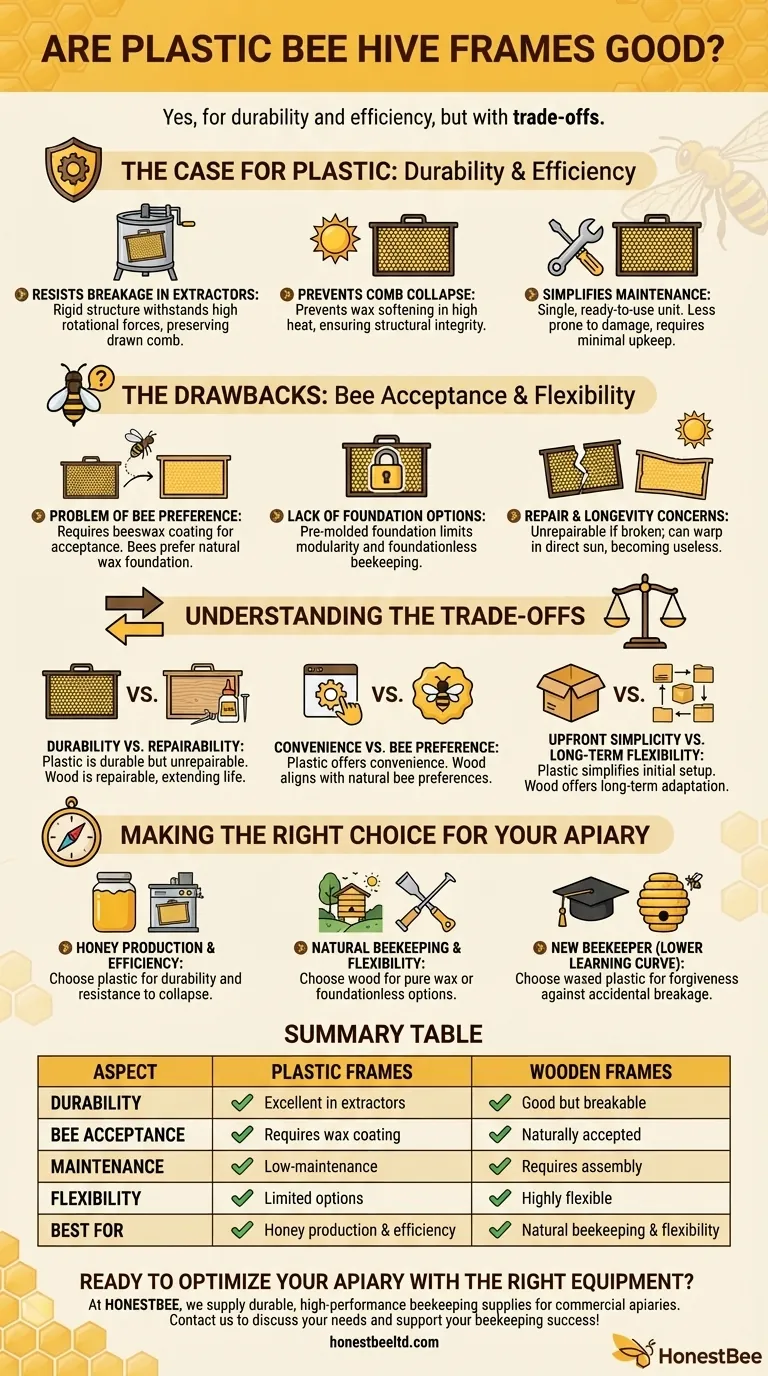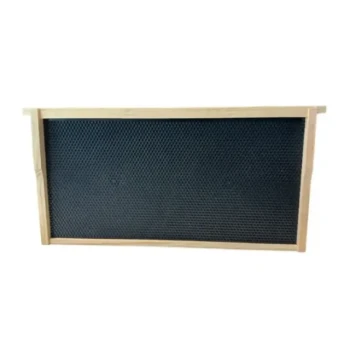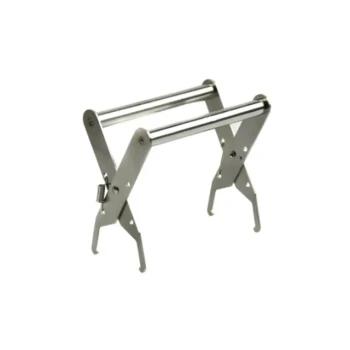Yes, plastic bee hive frames can be a very good choice, particularly for beekeepers who prioritize durability and efficiency in honey extraction. They are strong, low-maintenance, and significantly reduce the risk of comb breaking or collapsing, but this convenience comes with trade-offs regarding bee acceptance and operational flexibility.
The decision between plastic and traditional wood frames is not about which is universally "better," but which aligns with your specific goals. Plastic offers modern durability and convenience, while wood provides natural appeal and greater flexibility for the beekeeper.

The Case for Plastic: Durability and Efficiency
The primary advantages of plastic frames are rooted in their strength and simple, uniform design. This makes them a compelling option for certain beekeeping operations.
Resists Breakage in Extractors
A key benefit of plastic frames is their performance during honey harvesting. Their rigidity ensures they hold up well to the high rotational forces inside a honey extractor, preserving the valuable drawn-out comb for the bees to reuse immediately.
Prevents Comb Collapse
In regions with very high heat, natural wax comb on wooden frames can soften and collapse under its own weight. Plastic frames provide a rigid structure that completely prevents this costly and damaging issue.
Simplifies Maintenance
Unlike wooden frames that may require assembly, wiring, and foundation installation, most plastic frames are a single, ready-to-use unit. They are also less prone to damage from hive tools or pests and require minimal upkeep over their lifespan.
The Drawbacks: Bee Acceptance and Flexibility
While durable, plastic frames present challenges that are important to understand before committing to them.
The Problem of Bee Preference
Bees do not readily accept bare plastic. For bees to build comb on a plastic frame, it must be coated with a layer of real beeswax. Even then, if given a choice, bees will almost always draw out comb on a natural wax foundation before they will work on a plastic one.
Lack of Foundation Options
Plastic frames come with a pre-molded plastic foundation. This lack of modularity means you cannot switch to a different type of foundation or experiment with foundationless beekeeping, which is a significant limitation for some management styles.
Repair and Longevity Concerns
While durable in normal use, a broken plastic frame is typically unrepairable and must be discarded. Furthermore, under certain conditions, they can warp permanently, especially if left in direct sun, rendering them useless.
Understanding the Trade-offs: Plastic vs. Wood
Choosing your equipment requires an objective look at the compromises you are willing to make.
Durability vs. Repairability
Plastic is incredibly durable for its intended purpose, especially in the extractor. However, wood is far more repairable; a broken piece of a wooden frame can often be glued or nailed back together, extending its life.
Convenience vs. Bee Preference
Plastic frames offer undeniable convenience for the beekeeper. Wood frames, however, align more closely with the bees' natural preferences, which can lead to faster comb building and hive expansion.
Upfront Simplicity vs. Long-Term Flexibility
The all-in-one nature of plastic frames simplifies initial setup. Wooden frames demand more assembly but provide far greater long-term flexibility, allowing you to adapt your equipment as your beekeeping philosophy evolves.
Making the Right Choice for Your Apiary
Your specific goals as a beekeeper should be the deciding factor in your equipment selection.
- If your primary focus is honey production and operational efficiency: The durability of plastic frames during extraction and their resistance to collapse makes them a highly practical choice.
- If your primary focus is natural beekeeping and hive flexibility: Traditional wooden frames offer the ability to use pure wax foundations or go foundationless, aligning better with this approach.
- If you are a new beekeeper prioritizing a lower learning curve: Well-waxed plastic frames can be more forgiving, as they prevent the beginner mistake of accidentally breaking delicate new comb during inspections.
Ultimately, understanding the strengths and weaknesses of each material empowers you to build an apiary that works best for you and your bees.
Summary Table:
| Aspect | Plastic Frames | Wooden Frames |
|---|---|---|
| Durability | Excellent in extractors; resists comb collapse | Good, but can break; repairable |
| Bee Acceptance | Requires wax coating; bees may prefer wood | Naturally accepted; aligns with bee preferences |
| Maintenance | Low-maintenance; single-unit design | Requires assembly; more upkeep |
| Flexibility | Limited foundation options; less adaptable | Highly flexible; supports various foundations |
| Best For | Honey production, efficiency, and heat-prone areas | Natural beekeeping, flexibility, and repairs |
Ready to optimize your apiary with the right equipment?
At HONESTBEE, we supply durable, high-performance beekeeping supplies and equipment tailored for commercial apiaries and distributors. Whether you're scaling honey production or prioritizing natural hive management, our wholesale-focused operations ensure you get reliable gear that fits your goals.
Contact us today to discuss your needs and discover how HONESTBEE can support your beekeeping success!
Visual Guide

Related Products
- Plastic Bee Frame Beekeeping Hive Frames for Wholesale
- Assembled Wooden Bee Frames with Plastic Foundation for Durability and Convenience by HONESTBEE
- Food Grade Plastic bee Foundation for Bee Frames
- Mini Desktop Bee Hive Frame Forming Making Machine
- Heavy-Duty Stainless Steel Frame Grip
People Also Ask
- What are the advantages of plastic frames for beehives? Boost Apiary Efficiency & Durability
- Can beekeepers switch between wooden and plastic frames? Optimize Your Hive's Performance
- Why are plastic frames popular in commercial beekeeping? Boost Efficiency & Durability at Scale
- What is a general rule for beekeepers with many hives regarding frame choice? Maximize Efficiency with Plastic Frames
- Can you boil plastic bee frames? Avoid This Costly Mistake and Protect Your Hive



















